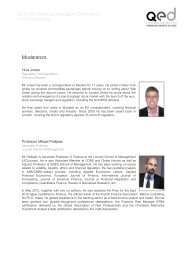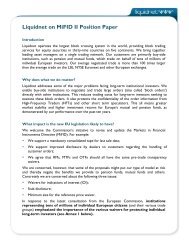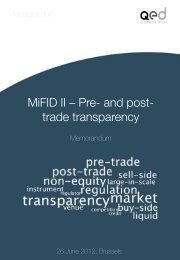FIA EPTA's position paper - Futures Industry Association
FIA EPTA's position paper - Futures Industry Association
FIA EPTA's position paper - Futures Industry Association
You also want an ePaper? Increase the reach of your titles
YUMPU automatically turns print PDFs into web optimized ePapers that Google loves.
volatility controls to pause trading when there is a significant price move, and clear and objective trade<br />
cancellation or modification rules.<br />
Order-to-Trade Ratios<br />
A regulated market‟s limits on the ratio of unexecuted orders to transactions – as required in Article 51(3)<br />
– can complement the markets‟ procedures and arrangements to ensure its trading systems have<br />
sufficient capacity to deal with peak order message volumes and to ensure orderly handling of trading in<br />
all market conditions. <strong>FIA</strong> ETPA, however, believes that limits on order-trade ratios are best left to trading<br />
venues (both regulated markets and MTFs) to determine, in consultation with their home country<br />
regulator. A one-size-fits-all approach, as currently contemplated would harm liquidity and discourage<br />
competition in certain asset classes.<br />
Regulators have an interest in trading platforms establishing order-to-trade ratios that ensure market<br />
participants do not send more messages than exchange systems can process. This ratio, however, will<br />
vary – sometimes dramatically – depending on a regulated market‟s technology and systems. Because<br />
there is a positive relationship between speed, capacity and liquidity, some trading venues may<br />
choose to invest heavily in the most up-to-date technology that allows the market to handle large volumes<br />
of information quickly..<br />
More importantly, new entrants, with few trades, will initially have much higher order-to-trade ratios as<br />
they try to gain market share from more established markets. For this reason, limiting the order-to-trade<br />
ratio on a basis other than the ability of a particular trading platform to handle messages would be anticompetitive<br />
because it would limit the ability of trading venues to compete on the basis of the quality of<br />
their systems and would be a barrier to entry to new markets. In addition to this, it will become virtually<br />
impossible for some derivative asset classes such as exchange traded options to be screen traded.<br />
Furthermore, exchanges have a strong economic incentive to limit excessive order messaging. In an<br />
environment where exchanges are competing for order flow, having the capacity to handle large numbers<br />
of order messages with little or no effect on system performance is an important competitive advantage.<br />
For this reason, technologically advanced exchanges such as Eurex, CME Group and<br />
IntercontinentalExchange have developed policies to penalize firms that engage in excessive messaging.<br />
In effect, the exchanges are discouraging the wasteful use of an expensive resource.<br />
<strong>FIA</strong> EPTA believes that reasonable order-trade ratios can complement other measures to ensure that<br />
markets‟ systems operate in an orderly manner. It is important that any order-to-trade ratios consider the<br />
following characteristics:<br />
(i)<br />
(ii)<br />
(iii)<br />
Liquid v. Illiquid Products. Trading venues need to consider the differences between liquid and<br />
illiquid products. Products that are traded infrequently will require higher order-to-trade ratios than<br />
high volume products.<br />
Type of Market Participants. Market makers that post quotes will send more messages than<br />
participants that remove those quotes. For this reason, market makers should be permitted higher<br />
order-to-trade ratios than other types of market participants. See for example the recent order to<br />
trade ratios set by Nasdaq and DirectEdge both of which provide for a market maker exemption. 10<br />
Impact on Spreads. Unless carefully tailored to the product and market, order-to-trade ratios can<br />
cause spreads to widen – thereby increasing costs to investors and potentially making over-thecounter<br />
markets and other “dark” venues more attractive.<br />
Minimum Order Resting Time<br />
Another method suggested for limiting the number of messages sent to markets is to require that orders<br />
rest on the market for a minimum period of time, for example 500 milliseconds. However, unlike order-totrade<br />
ratios, which can be designed to eliminate inefficient quoting without impacting the quality of quotes,<br />
a minimum resting time for all orders or quotes would increase the market risk of posting such an order or<br />
quote. Requiring participants to expose themselves to the risk of a market move for an artificial length of<br />
time would cause providers of liquidity to adjust their pricing to accommodate the uncertainty of market<br />
10<br />
Direct Edge introduces Message Efficiency Incentive Program (MEIP) effective May 1, 2012, pending SEC approval<br />
[http://us1.campaign-archive2.com/?u=cff218c930bf350c436e935c0&id=f46265dc2d&e=47d2396067] and NASDAQ, BX and PSX<br />
Excessive Messaging Policy [http://www.nasdaqtrader.com/TraderNews.aspx?id=ETA2012-13]<br />
4










